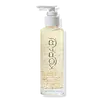What's inside
What's inside
 Key Ingredients
Key Ingredients

 Benefits
Benefits

 Concerns
Concerns

 Ingredients Side-by-side
Ingredients Side-by-side

Helianthus Annuus Seed Oil
EmollientC12-15 Alkyl Benzoate
AntimicrobialButyrospermum Parkii Oil
EmollientParfum
MaskingCaprylic/Capric Triglyceride
MaskingCocos Nucifera Oil
MaskingTocopherol
AntioxidantGlycine Soja Oil
EmollientSqualane
EmollientRicinus Communis Seed Oil
MaskingGold
Cosmetic ColorantSodium Hyaluronate
HumectantHydrogenated Castor Oil
EmollientBenzyl Alcohol
PerfumingCoumarin
PerfumingHexyl Cinnamal
PerfumingCI 77820
Cosmetic ColorantCI 77400
Cosmetic ColorantHelianthus Annuus Seed Oil, C12-15 Alkyl Benzoate, Butyrospermum Parkii Oil, Parfum, Caprylic/Capric Triglyceride, Cocos Nucifera Oil, Tocopherol, Glycine Soja Oil, Squalane, Ricinus Communis Seed Oil, Gold, Sodium Hyaluronate, Hydrogenated Castor Oil, Benzyl Alcohol, Coumarin, Hexyl Cinnamal, CI 77820, CI 77400
Water
Skin ConditioningKaolin
AbrasiveBentonite
AbsorbentGlycerin
HumectantLactobacillus
Skin ConditioningGlyceryl Stearate
EmollientNiacinamide
SmoothingPropanediol
SolventCetearyl Alcohol
EmollientCocos Nucifera Oil
MaskingSimmondsia Chinensis Seed Oil
EmollientCocos Nucifera Water
MaskingHylocereus Undatus Extract
Skin ConditioningHamamelis Virginiana Water
AstringentTocopherol
AntioxidantCaesalpinia Sappan Bark Extract
Skin ConditioningThymus Vulgaris Oil
MaskingAvena Sativa Kernel Oil
Skin ConditioningSaccharide Isomerate
HumectantAcacia Catechu Gum
MaskingXanthan Gum
EmulsifyingSodium Stearoyl Lactylate
EmulsifyingHydrogenated Farnesene
EmollientTetrasodium Glutamate Diacetate
Mica
Cosmetic ColorantRicinus Communis Seed Oil
MaskingEthylhexylglycerin
Skin ConditioningSodium Phytate
Citric Acid
BufferingAllantoin
Skin ConditioningTin Oxide
AbrasiveSodium Citrate
BufferingPhenoxyethanol
PreservativeTitanium Dioxide
Cosmetic ColorantCI 17200
Cosmetic ColorantWater, Kaolin, Bentonite, Glycerin, Lactobacillus, Glyceryl Stearate, Niacinamide, Propanediol, Cetearyl Alcohol, Cocos Nucifera Oil, Simmondsia Chinensis Seed Oil, Cocos Nucifera Water, Hylocereus Undatus Extract, Hamamelis Virginiana Water, Tocopherol, Caesalpinia Sappan Bark Extract, Thymus Vulgaris Oil, Avena Sativa Kernel Oil, Saccharide Isomerate, Acacia Catechu Gum, Xanthan Gum, Sodium Stearoyl Lactylate, Hydrogenated Farnesene, Tetrasodium Glutamate Diacetate, Mica, Ricinus Communis Seed Oil, Ethylhexylglycerin, Sodium Phytate, Citric Acid, Allantoin, Tin Oxide, Sodium Citrate, Phenoxyethanol, Titanium Dioxide, CI 17200
 Reviews
Reviews

Ingredients Explained
These ingredients are found in both products.
Ingredients higher up in an ingredient list are typically present in a larger amount.
Cocos Nucifera Oil is obtained from the kernels of the coconut fruit. In other words, this is coconut oil.
Coconut Oil is rich in fatty acids with lauric acid making up the majority of these. It also contains linoleic acid. Due to this high fatty acid content, coconut oil helps trap moisture and soften skin.
Despite being antibacterial, coconut oil may not be great for acne-prone skin. It is comedogenic and may clog pores. This ingredient may not be safe for malassezia or fungal acne.
Note: Coconut Oil should not replace your sunscreen for UV protection. Studies show it only blocks about 20% of UV.
This oil is non-volatile and has a light scent.
The term 'fragrance' is not regulated in many countries. In many cases, it is up to the brand to define this term. For instance, many brands choose to label themselves as "fragrance-free" because they are not using synthetic fragrances. However, their products may still contain ingredients such as essential oils that are considered a fragrance.
Learn more about Cocos Nucifera OilRicinus Communis Seed Oil is the INCI name for castor oil.
Castor Oil helps moisturize the skin. It is rich in a fatty acid called ricinoleic acid. This fatty acid helps prevent moisture loss on the skin. This helps keep your skin soft and hydrated. Ricinoleic acid also has anti-inflammatory and pain reducing properties.
Besides hydrating the skin, castor oil is also used to hydrate hair. By keeping the hair shaft moisturized, breakage is decreased. More studies are needed to show castor oil's effective on stimulating hair growth.
Castor oil is created by cold-pressing castor seeds and then purifying the oil with heat. It was used in Ancient Egypt as fuel in lamps and to help treat eye irritation.
The term 'fragrance' is not regulated in many countries. In many cases, it is up to the brand to define this term. For instance, many brands choose to label themselves as "fragrance-free" because they are not using synthetic fragrances. However, their products may still contain ingredients such as essential oils that are considered a fragrance.
Learn more about Ricinus Communis Seed OilTocopherol (also known as Vitamin E) is a common antioxidant used to help protect the skin from free-radicals and strengthen the skin barrier. It's also fat soluble - this means our skin is great at absorbing it.
Vitamin E also helps keep your natural skin lipids healthy. Your lipid skin barrier naturally consists of lipids, ceramides, and fatty acids. Vitamin E offers extra protection for your skin’s lipid barrier, keeping your skin healthy and nourished.
Another benefit is a bit of UV protection. Vitamin E helps reduce the damage caused by UVB rays. (It should not replace your sunscreen). Combining it with Vitamin C can decrease sunburned cells and hyperpigmentation after UV exposure.
You might have noticed Vitamin E + C often paired together. This is because it is great at stabilizing Vitamin C. Using the two together helps increase the effectiveness of both ingredients.
There are often claims that Vitamin E can reduce/prevent scarring, but these claims haven't been confirmed by scientific research.
Learn more about Tocopherol